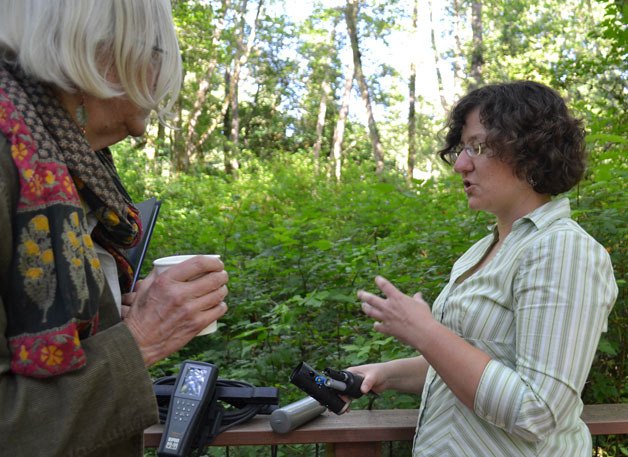Testing for the Maxwelton watershed Water Quality Improvement Project reached the midway point last month with results thus far well below state standards.
Representatives from Island County Public Health, Island County Department of Natural Resources, Whidbey Watershed Stewards and Whidbey Island Conservation District presented their findings and gave information on water quality June 3 at the Outdoor Classroom.
Researchers have been analyzing the 10-square-mile area since May 2012 following state findings of high levels of fecal bacteria, and have found many things are contributing to water contamination. Research will continue through June 2014.
“It’s a classic non-point pollution case,” said Karen DuBose, a water quality specialist for Island County Public Health. “We aren’t going to find a single source.”
DuBose said this is because of the size of the area, which constitutes the largest watershed in Island County and has a commensurate share of animal waste and failing septic systems.
The state standards require that the geometric mean, which is the average used for bacteria testing, be less than 50 colony forming units per 100 milliliters. Each bacteria has the ability to form a colony. The state also requires no more than 10 percent of samples exceeding 100 colonies per 100 milliliters.
Maxwelton beach exceeds both parts of the state standards, averaging 59 colony forming units and 50 percent of samples were over 100 colonies per 100 milliliters.
“That’s why we’re in the Maxwelton watershed. People want to eat the shellfish from the area and we’re concerned about their health if they aren’t cooking it fully. Our job is essentially to clean it up,” DuBose said.
The findings are a result of the 2012 grant through the Department of Ecology to identify the contamination and improve water quality in the Maxwelton watershed.
Kira Swanson, a critical areas planner for Island County Clean Water Utility, said this type of non-point pollution is tricky to identify.
“It could be a lot of small factors that by the time it reaches the watershed it could create big problems,” she said.
Swanson helps identify the human factors and looks for code violations. She said she wants to emphasize to landowners that they do the best they can to protect the area.
Carolyn Geise, a resident near the watershed, attended the presentation because she would like to be able to dig clams again. She said one should be aware of these issues for the health of the planet.
“It’s important to know it’s not just our animals that are contaminating,” she said.
Geise said she wanted to learn what needs to be done to improve the Maxwelton environment.
Part of the improvement project includes education on what affects the water quality. Groups are working with farmers to pinpoint what may negatively impact water quality, asking people to inspect their septic systems and slow storm water from entering the creek and, importantly, to pick up after their dogs.
“Dog poop specifically has a ton of bacteria in it,” DuBose said. “One dog can pollute 2.1 Olympic sized swimming pools in one day. There are easily a couple hundred dogs in the Maxwelton area.”
Dogs and humans produce more fecal coliform bacteria than other animals because of both a diverse diet and the type of digestive system, she said.
“We’ve taken a lot of what we’ve learned from Holmes Harbor research and applied it here,” DuBose said. “It’s harder to identify the source here because the houses aren’t as dense. Starting this has been a learning curve.”
Holmes Harbor was closed to clamming and swimming for several years, but water quality improvements attributed to community efforts may lead to a lifting of restrictions later this year.
DuBose demonstrated one of the tests she uses in the field for surface water. She tested for electrical conductance, water oxygen and pH levels. She has sampled 11 regular sites in the area for fecal coliform.
“None of us want to think we impact the watershed,” DuBose said. “But it’s the little things like when we don’t pick up our dog poop and checking our septic tanks that impact the watershed.”



